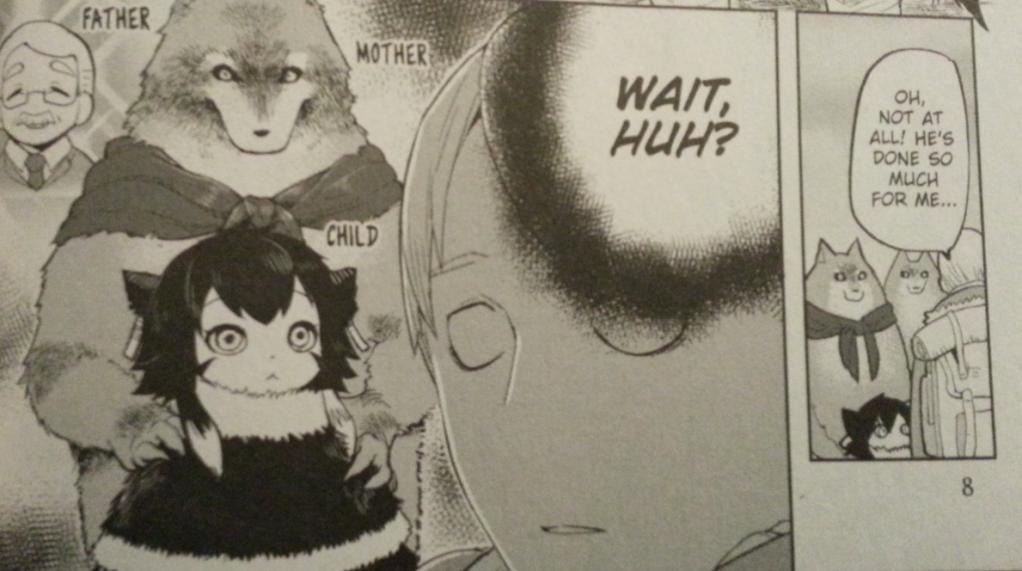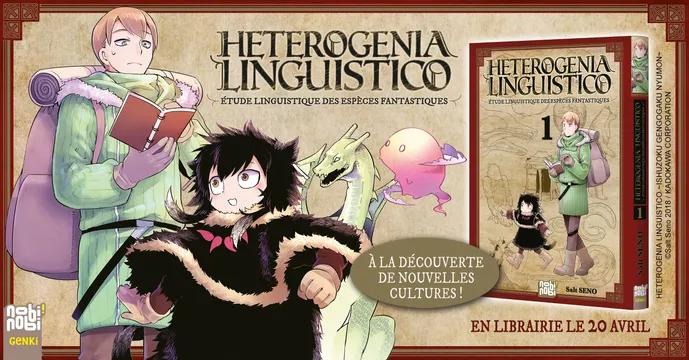I first discovered Heterogenia Linguistico on ComicK, and it immediately captured me in a way few fantasy manga do. Instead of chasing battles or epic quests, it immerses you in a world where understanding languages and cultures from werewolves to dragons drives the story.
Reading it felt like joining Hakaba on his fieldwork, marveling at every nuance, miscommunication, and cultural quirk, and I found myself laughing, learning, and genuinely caring about each encounter along the way.
Hakaba: The Observer Who Wins Your Heart
Hakaba isn’t your typical hero. He doesn’t charge into battle or boast about superhuman skills. Instead, he’s curious, attentive, and endlessly patient traits that made me feel like I was learning right alongside him. Watching him interact with Susuki, his half-werewolf guide, was both heartwarming and amusing; Susuki’s playful, puppy-like energy contrasts perfectly with Hakaba’s studious intensity.
I admired how Hakaba treats each new encounter as a chance to learn rather than conquer. When he meets a group of lizardfolk or a minotaur, he isn’t looking for action; he’s trying to understand. That mindset is rare in fantasy protagonists, and it made the story feel like a genuine exploration rather than a race to some arbitrary goal.
Through Hakaba’s eyes, I felt both the excitement and the exhaustion of fieldwork. His nervous sweat, wide-eyed wonder, and careful note taking made the Netherworld feel like a living, breathing ecosystem rather than just a backdrop. It was easy to get emotionally invested because Hakaba’s enthusiasm is contagious.

Interspecies Communication: A Mind Bending Challenge
One of the most fascinating aspects of this manga is its focus on communication. Each species has its own language, gestures, or even color based signals that humans can barely perceive. At first, I admit I was overwhelmed trying to keep track of it all and I suspect Hakaba was too. But slowly, you start appreciating the depth and logic behind every interaction.
There’s something profoundly human about watching a character stumble and then succeed at understanding a completely alien culture. I found myself laughing at Hakaba’s initial misinterpretations and celebrating his small breakthroughs. It reminded me of traveling to a foreign country and realizing that learning to communicate is more about patience and observation than vocabulary alone.
Seno’s attention to detail elevates this theme. Even sketches of kilns, food production, and homes aren’t filler; they’re part of the linguistic and cultural tapestry. Every little detail reinforced that this was a story about understanding others a lesson I didn’t realize I needed until I was halfway through the volume.
Susuki: Fluffy, Mischievous, and Endearing
Susuki stole my heart from the first panel. Her half-werewolf nature combines the best of both worlds: playful, childlike curiosity with hints of untamed wildness. She challenges Hakaba but also guides him, creating a dynamic that is both humorous and emotionally resonant.
I laughed out loud at her antics, especially when she mischievously reacts to Hakaba’s mistakes. At the same time, there are moments of quiet tenderness that made me genuinely care about her wellbeing. She isn’t just comic relief; she’s a fully realized character whose perspective enriches the story.
Watching Hakaba and Susuki navigate the Netherworld together felt almost like witnessing a dance: tentative steps, miscommunications, sudden missteps, and small triumphs. Their chemistry platonic but deeply connected added layers of warmth to an otherwise academically focused narrative.
The Netherworld: Richly Detailed and Believably Strange
The Netherworld isn’t just a backdrop; it’s a character in its own right. Every species, every shelter, every food ritual feels carefully considered. I loved how Seno allowed me to explore these cultures with Hakaba’s eyes, noticing nuances and patterns I would have otherwise missed.
What struck me most was how realistic the social interactions were. Creatures aren’t hostile for no reason; they aren’t overly friendly either. They simply exist with their own priorities, and Hakaba’s human-centric assumptions are constantly challenged. I found myself reflecting on how often I unconsciously project human norms onto others a surprisingly introspective takeaway for a fantasy manga.
Even the smallest details a subtle gesture from a harpy, a color change in a lizardfolk’s scales carried meaning. Reading these panels felt like decoding a secret language, and I couldn’t get enough.

Art Style: Clean, Precise, and Emotionally Expressive
Seno’s fine-lined art immediately reminded me of Ryoko Kui’s work, but with a softer, more observational touch. The characters’ expressions are subtle yet expressive, perfectly capturing Hakaba’s nervous excitement or Susuki’s playful mischief.
The minimalist action sequences work in the story’s favor. Because the focus isn’t on combat, every gesture, glance, or scribbled journal entry carries emotional weight. Even background details are purposeful, contributing to the sense of a living, breathing world.
I particularly appreciated how the art conveys culture. Sketches of daily life food, shelter, tools never felt like exposition dumps. Instead, they made me feel like I was participating in Hakaba’s fieldwork, studying these creatures firsthand. It was immersive in a way few manga manage.
Why Heterogenia Linguistico Is Worth Exploring
If you’re looking for a fantasy that’s quiet but deeply rewarding, Heterogenia Linguistico is a gem. It’s not about epic battles or dramatic power-ups; it’s about curiosity, understanding, and empathy. I found myself learning alongside Hakaba, laughing at his mistakes, and marveling at the Netherworld’s complexities.
This manga feels like a meditative experience, where observing and thinking critically are more important than action. For adult readers or those who appreciate linguistics, anthropology, or detailed worldbuilding, it’s pure joy. It’s the kind of story that lingers in your mind long after you’ve closed the volume.
So if you’re ready to explore languages, cultures, and magical beings through the eyes of a genuinely curious protagonist, give Heterogenia Linguistico a read on ComicK. Trust me it’s a rare fantasy that teaches patience, wonder, and respect for the “other” without ever feeling preachy.
